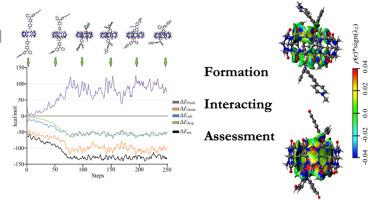Mechanochromic Emission in Ternary CB[8]TPA2 Array. Insights into the Role of Host-Interaction Nature
IF 4.2
3区 工程技术
Q2 CHEMISTRY, APPLIED
引用次数: 0
Abstract
The formation of host-guest aggregates favors the enhancement of molecular properties owing to the molecular confinement into a suitable cavity. This report provides an overview of the binding and emission features in ternary host-guest systems, with a particular focus on cucurbituril (CB[8]) systems. Our results reveal the crucial role of host-guest interactions in modulating mechano-chromic luminescent properties through various organic compounds, such as TPA derivatives. Advanced computational methodologies, including density functional theory (DFT), time-dependent DFT (TDDFT), and Energy Decomposition Analysis based on Natural Orbitals for Chemical Valence (EDA-NOCV), are employed to analyze orbital density of transitions, energy interactions, charge transfer mechanisms, and the stability of these complexes. Key findings highlight the contributions of electrostatic, orbital, and dispersion interactions, which enhance our understanding of photophysical behavior. In this sense, the host-guest interaction is predominantly from the ΔEelstat term, which retains 54% to 57% in attractive forces, and the ΔEdisp term goes from 24% to 27%. Additionally, the CB-encapsulation demonstrates its potential application in innovative materials and MCL response, highlighting the possible significance of molecular design. This report aims to provide a comprehensive understanding of the intricate dynamics within these systems.

三元CB[8]TPA2阵列的机械致色发射。对宿主相互作用性质的认识
由于分子被限制在合适的腔内,主客体聚集体的形成有利于分子性质的增强。本文概述了三元主-客体系统的结合和发射特性,特别关注葫芦脲(CB[8])系统。我们的研究结果揭示了主客体相互作用在通过各种有机化合物(如TPA衍生物)调节机械致变色发光特性中的关键作用。采用密度泛函理论(DFT)、时变DFT (TDDFT)和基于化学价态自然轨道的能量分解分析(EDA-NOCV)等先进的计算方法分析了这些配合物的跃迁轨道密度、能量相互作用、电荷转移机制和稳定性。关键发现强调了静电、轨道和色散相互作用的贡献,这增强了我们对光物理行为的理解。从这个意义上说,主客互动主要来自ΔEelstat项,它保留了54%到57%的吸引力,ΔEdisp项从24%到27%。此外,cb封装在创新材料和MCL响应方面的潜在应用,突出了分子设计的可能意义。本报告旨在提供对这些系统中复杂动态的全面理解。
本文章由计算机程序翻译,如有差异,请以英文原文为准。
求助全文
约1分钟内获得全文
求助全文
来源期刊

Dyes and Pigments
工程技术-材料科学:纺织
CiteScore
8.20
自引率
13.30%
发文量
933
审稿时长
33 days
期刊介绍:
Dyes and Pigments covers the scientific and technical aspects of the chemistry and physics of dyes, pigments and their intermediates. Emphasis is placed on the properties of the colouring matters themselves rather than on their applications or the system in which they may be applied.
Thus the journal accepts research and review papers on the synthesis of dyes, pigments and intermediates, their physical or chemical properties, e.g. spectroscopic, surface, solution or solid state characteristics, the physical aspects of their preparation, e.g. precipitation, nucleation and growth, crystal formation, liquid crystalline characteristics, their photochemical, ecological or biological properties and the relationship between colour and chemical constitution. However, papers are considered which deal with the more fundamental aspects of colourant application and of the interactions of colourants with substrates or media.
The journal will interest a wide variety of workers in a range of disciplines whose work involves dyes, pigments and their intermediates, and provides a platform for investigators with common interests but diverse fields of activity such as cosmetics, reprographics, dye and pigment synthesis, medical research, polymers, etc.
 求助内容:
求助内容: 应助结果提醒方式:
应助结果提醒方式:


